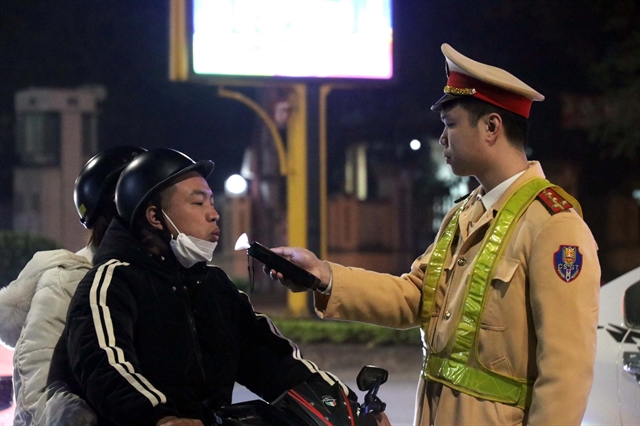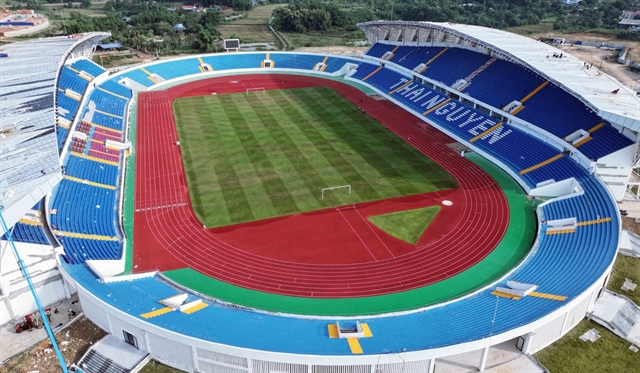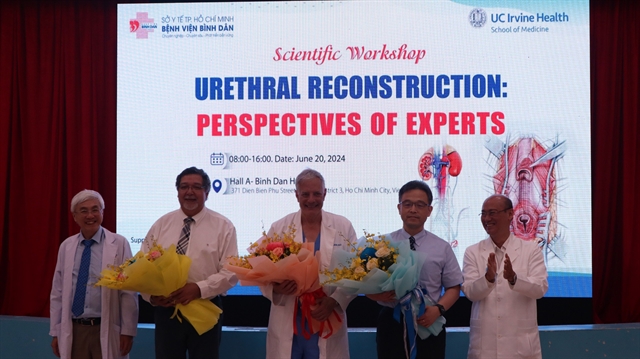 Society
Society

 |
| HCM City-based Bình Dân Hospital doctors perform surgery on a patient with a severe urethral stricture. — Photo courtesy of Bình Dân Hospital |
HCM CITY — If not treated properly, patients with urethral strictures may have to get multiple surgeries or wear a urinary catheter for their whole life, leading doctors said at a recent workshop in HCM City.
The workshop called “Urethral reconstruction: Perspectives of experts” held at Bình Dân Hospital last week attracted leading experts in the field of urethral stricture treatment from around the world.
Đỗ Lệnh Hùng, head of the Urethra Unit at Bình Dân Hospital, said the number of urethral stricture cases seeking treatment at the hospital is increasing.
Each year, the hospital doctors perform surgery on more than 800 patients with urethral stricture, and examine and treat about 10,000 other cases.
Since 2015, UC Irvine University in the United States has transferred surgical techniques for urethral stricture, and provided professional support to Bình Dân Hospital doctors.
The hospital has not only transferred these techniques to domestic hospitals but also to hospitals in Southeast Asian countries such as Thailand and Malaysia.
The hospital’s success rate in urethroplasty surgery is 98 per cent, equivalent to the results of leading urethroplasty centres in the US.
Francisco E. Martins, head of Reconstructive Urology Unit at Santa Maria University Hospital in Portugal, discussed non-traumatic posterior urethral obstruction.
Urinary obstruction is a common complication of prostate cancer (PCa) treatments, and leads to serious morbidity and detriment to the patient’s quality of life.
“Pathogenesis of Vesicourethral anastomotic stenosis (VUAS) varies with PCa treatment type, leading to individual management considerations,” he said.
Endoscopic management can be considered for all radiation VUAS. Open reconstruction is potentially associated with increased morbidity.
Although challenging, successful reconstruction with lasting patency is possible for complex radiation VUA stenoses.
“Recognise unsalvageable (devastated) situations, these patients should be referred to tertiary, high-volume, academic centres for management by urethral reconstructive experts,” he added.
Akio Horiguchi, from the Department of Urology at National Defense Medical College in Japan, said male urethral stricture is a common and challenging urologic condition in males.
The goal of urethral stricture treatment is normal voiding and freedom from instrumentation.
“Urethroplasty is the only curative option for the majority of urethral strictures,” he said.
Urethroplasty is the gold standard of bulbar stricture.
Excision and primary anastomosis is suitable for short proximal bulbar stricture and substitution urethroplasty is suitable for lengthy bulbar and mid to distal bulbar urethral strictures.
“The key to success is to select a procedure appropriate for the stricture’s status and location,” he added.
 |
| A workshop called “Urethral reconstruction: Perspectives of experts” was held at Bình Dân Hospital in HCM City on June 20 . — Photo courtesy of Bình Dân Hospital |
Professor Joel Gelman from UC Irvine University in the US said that to have a high success rate in urethroplasty surgery, doctors must undergo intensive training and practice to gain experience, from several months to several years.
In addition, hospitals need to have specialised surgical equipment and improve the capabilities of diagnostic medical imaging.
“Strategic development and support from the hospitals' board of directors are very important,” he said.
On this occasion, the hospital's doctors and a delegation led by Joel Gelman performed surgery on a patient with a severe urethral stricture and stones.
The symptoms that the patient has are dysuria and impaired urination, and prolonged dysuria leading to urinary retention. He also has hypertension and gout.
The doctors performed endoscopic to remove urethral stones, and suprapubic cystostomy was placed to manage urethral stricture. — VNS